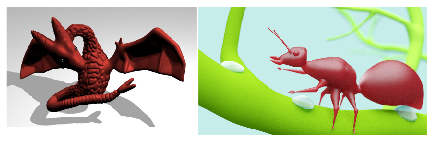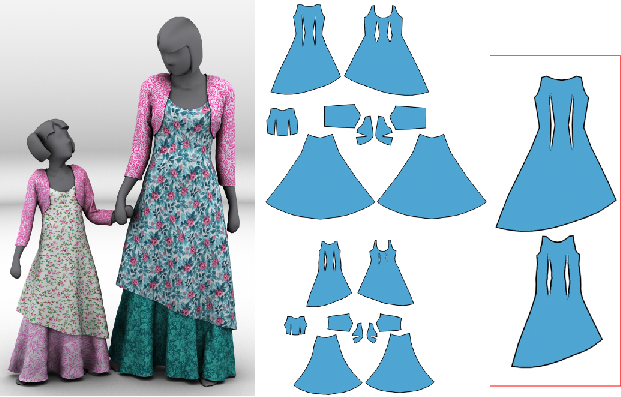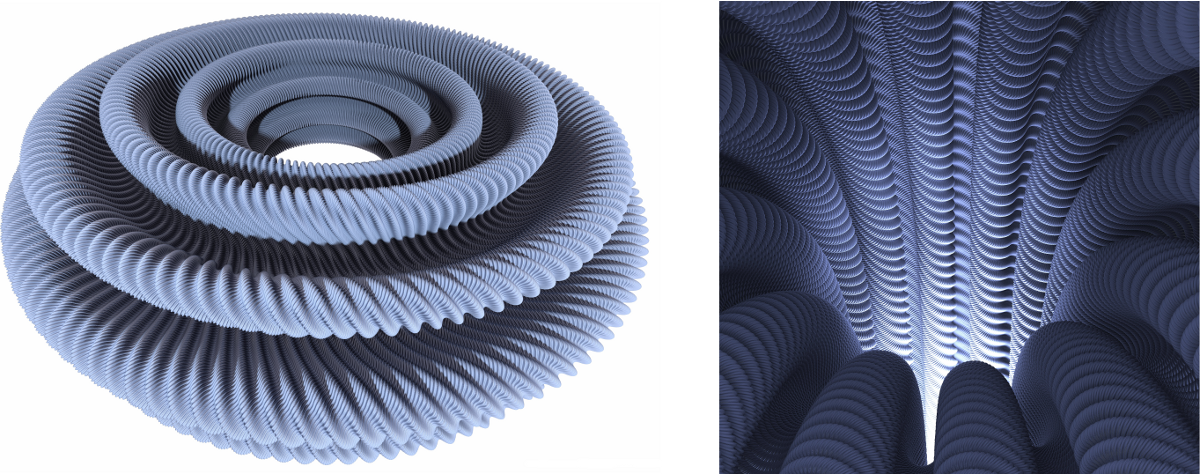Section: New Results
High level model for shapes
Implicit surface modeling
Participants : Adrien Bernhardt, Marie-Paule Cani, Maxime Quiblier, Cédric Zanni.
Implicit surfaces are an appealing representation for free-form, volumetric shapes. In addition to being able to represent shapes of arbitrary topological genius, they have the ability to be constructed by successively blending different components, which eases interactive modeling.
In collaboration with a researcher in formal computation, Evelyne Hubert, we improved and extended the analytical methods for computing closed form solutions for convolution surfaces [6] .
Within Cédric Zanni’s PhD we proposed a method based on anisotropic, surface Gabor noise, for generating procedural details on skeleton-based implicit surfaces, see Figure 4 (left). The surfaces enhanced with details can still be smoothly blended, with a natural transition between the details they carry [19] .
|
We also developed an extension to convolution surfaces, so-called scale-invariant integral surfaces, see Figure 4 (right). Thanks to blending properties that are scale invariant these surfaces have three major advantages: the radius of the surface around a skeleton can be explicitly controlled, shapes generated in blending regions are self-similar regardless of the scale of the model, and thin shape components are not smoothed-out anymore when blended into larger ones. This work has been presented at AFIG2012 [23] and submitted for international publication.
Lastly, in collaboration with Loic Barthe in Toulouse, we contributed to a new blending operator, gradient blending, which enables us to blend implicit shapes not only in function of the field values but also of their gradients. This solves a number long standing problems in implicit modeling: we can generate bulge-free blending, ensure that the topological genius of the blended shape remains the one of the union of the input one, and avoid the blur of small details. A paper has been accepted for publication in ACM ToG [4] .
Developable surfaces
Participants : Rémi Brouet, Marie-Paule Cani, Stefanie Hahmann, Damien Rohmer.
|
A developable surface is a surface, which can be unfolded (developed) into a plane without stretching or tearing. Because of this property, developable surfaces lead to a variety of applications in manufacturing with materials that are not amenable to stretching (leather for shoes or hand bags, skins of aircrafts, sails). In computer graphics developable surfaces are very popular to model, simulate or animate clothes or folded papers in virtual environments.
In collaboration with Alla Sheffer (University of British Columbia, Canada visiting Inria) we developed a fully automatic method for design-preserving transfer of garments between characters with different body shapes. The method is able to generate design-preserving versions of existing garments for target characters whose proportions and body shape significantly differ from those of the source. The work has been presented at SIGGRAPH 2012 [1] .
Folded paper exhibits very characteristic shapes, due to the presence of sharp folds and to exact isometry with a given planar pattern. In the past we proposed a purely geometric solution to generate static folded paper geometry from a 2D pattern and a 3D placement of its contour curve. Current research focuss on the interactive manipulation of the folded surface without the strong requirement of starting by an initial contour curve, but using sparser positional constraints on the surface.
Damien Rohmer joined in 2012 the Hevea project: this is a project in collaboration between Vincent Borrelli (Institut Camille Jordan, Lyon), Boris Thibert (MGMI, LJK Grenoble) and Francis Lazarus (Gipsa Lab, Grenoble) focussed on the generation and visualisation of the flat torus. The flat torus is a mathematical smooth surface with the topology of a torus but having locally the metric of the plane. In other word, this is a developable torus. So far, no representation of such object had ever being made. In 2012, based on a convex integration algorithm generating coherent wrinkles on the torus called corrugations, we generated the first representation of such object that is both while being fractal as the number of wrinkles has to tend to infinity to converge toward true developability. The rendering made by Damien Rohmer has been used for the cover image of Proceedings of the National Academy of Sciences (PNAS) (http://www.pnas.org/content/109/19.cover-expansion ).
Parametric surfaces
Participant : Stefanie Hahmann.
We are developing new smooth parametric surface models defined on irregular quad meshes. They are in fact a powerful alternative to singularly parameterized tensor product surfaces since they combine the advantages of both, the arbitrary topology of quad meshes and the smoothness of the tensor product patches.
In collaboration with G.-P. Bonneau (Maverick team) several parametric triangular surface models for arbitrary topologies have been published in the past (CAGD, IEEE TVCG and ACM ToG). A new tensor product spline surface model has been developed this year. It solves the problem of defining a G-continuous surface interpolating the vertices of an irregular quad mesh with low degree polynomial tensor product patches. It further aims to produce shapes of very high visual quality while reducing the number of control points. A comparison with existing methods and a journal paper are in preparation.
Fibrous structures
Participant : Damien Rohmer.
|
Due to anisotropy, fibrous structures may exhibit complex deformation properties. These properties are of main interest to understand the behavior of some human organs such as the heart.
In collaboration with Grant Gullberg, Archontis Giannakidis from Lawrence Berkeley Laboratory, and Alexander Veress from University of Washington we developped a new visualization of heart defects based on the fibrous structure organization. Combining 3D visualization with the fiber structure analysis may help to detect heart defects such as cardiac Hypertrophy. This work as been published as a book chapter [29] .
Virtual Prototypes
Participants : Flavien Boussuge, Francois Faure, Stefanie Hahmann, Jean-Claude Léon.
In the context of virtual prototyping (process of product development involving CAD/CAE software), a DMU (digital mock up) is the container of all the components of a 3D virtual product that be used during design and simulations.
Herein geometric interfaces, i.e. the imprint of a component onto each of its neighboring components, must be taken into account to generate simulation models. Indeed, a DMU does not contain these geometric interfaces. However, extensive use of CAD assemblies has led to increasingly complex DMUs with up to hundreds of thousands of components. The detection and generation of the geometric interfaces between all components with existing software is a very tedious task, which may require hours or days of user-interaction or is even not possible. As part of the ANR project ROMMA in collaboration with Georges-Pierre Bonneau and Francois Jourdes from the Maverick team, we developed a new method to rapidly detect and precisely describe the geometry of interfaces in highly complex assemblies [20] .
Within the PhD of Flavien Boussuge, we take advantage of these interfaces to focus on the generation of mixed dimensional models from enriched DMUs for FE analysis of structural assemblies. The goal is to provide a methodology and operators for transforming geometries of complex assemblies so that they are directly usable for FE mesh generation. A first contribution to assembly model preparation for simulation has been presented at ECT12 [11] . Herein, a model preparation methodology has been proposed that addresses the shape transformation categories specific to assemblies. Current and future research includes the generation of construction graphs of volume models that contribute to idealization operators. These algorithms take the simulation objectives into account as part of the proposed methodology.
Another important issue connected to geometry transformation of assemblies and construction graphs of volume models relates to the global as well as partial symmetries of components and assemblies. Here, symmetry analysis is applied to B-Rep NURBS models and must be obtained within the tolerance of a geometric modeler, which differs rather significantly from approximate symmetries extracted from meshes. The symmetry analysis helps structuring the construction graphs of volume models to take into account repetitive locations of primitives. Also, symmetry properties combine with functional annotations of components to enhance their search and retrieval[16] .






